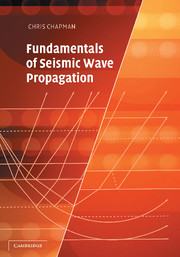Book contents
- Frontmatter
- Contents
- Preface
- Preliminaries
- 1 Introduction
- 2 Basic wave propagation
- 3 Transforms
- 4 Review of continuum mechanics and elastic waves
- 5 Asymptotic ray theory
- 6 Rays at an interface
- 7 Differential systems for stratified media
- 8 Inverse transforms for stratified media
- 9 Canonical signals
- 10 Generalizations of ray theory
- Appendices
- Bibliography
- Author index
- Subject index
1 - Introduction
Published online by Cambridge University Press: 19 January 2010
- Frontmatter
- Contents
- Preface
- Preliminaries
- 1 Introduction
- 2 Basic wave propagation
- 3 Transforms
- 4 Review of continuum mechanics and elastic waves
- 5 Asymptotic ray theory
- 6 Rays at an interface
- 7 Differential systems for stratified media
- 8 Inverse transforms for stratified media
- 9 Canonical signals
- 10 Generalizations of ray theory
- Appendices
- Bibliography
- Author index
- Subject index
Summary
Numerical simulations of the propagation of elastic waves in realistic Earth models can now be calculated routinely and used as an aid to survey design, interpretation and inversion of data. The theory of elastodynamics is complicated enough, and models depend on enough multiple parameters, that computers are almost essential to evaluate final results numerically. Nevertheless a wide variety of methods have been developed ranging from exact analytical results (in homogeneous media and in homogeneous layered media, e.g. the Cagniard method), through approximations (asymptotic or iterative, e.g. ray theory and the WKBJ method), transform methods in stratified media (propagator matrix methods, e.g. the reflectivity method), to purely numerical methods (e.g. finite-difference, finite-element or spectral-element methods), in one, two and three-dimensional models. Recent extensions of approximate methods, e.g. the Maslov method, quasi-isotropic ray theory, and Born scattering theory and the Kirchhoff surface integral method applied to anisotropic, complex media have extended the range of application and/or validity of the basic methods.
Although the purely numerical methods can now be used routinely in modelling and interpretation, the analytic, asymptotic and approximate methods are still useful. There are three main reasons why the simpler, approximate but less expensive methods are useful and worth studying (and developing further). First, complete numerical calculations in realistic Earth models are as complicated to interpret as real data. Interpretation normally requires different parts of the signal to be identified and used in interpretation.
- Type
- Chapter
- Information
- Fundamentals of Seismic Wave Propagation , pp. 1 - 5Publisher: Cambridge University PressPrint publication year: 2004
- 2
- Cited by



